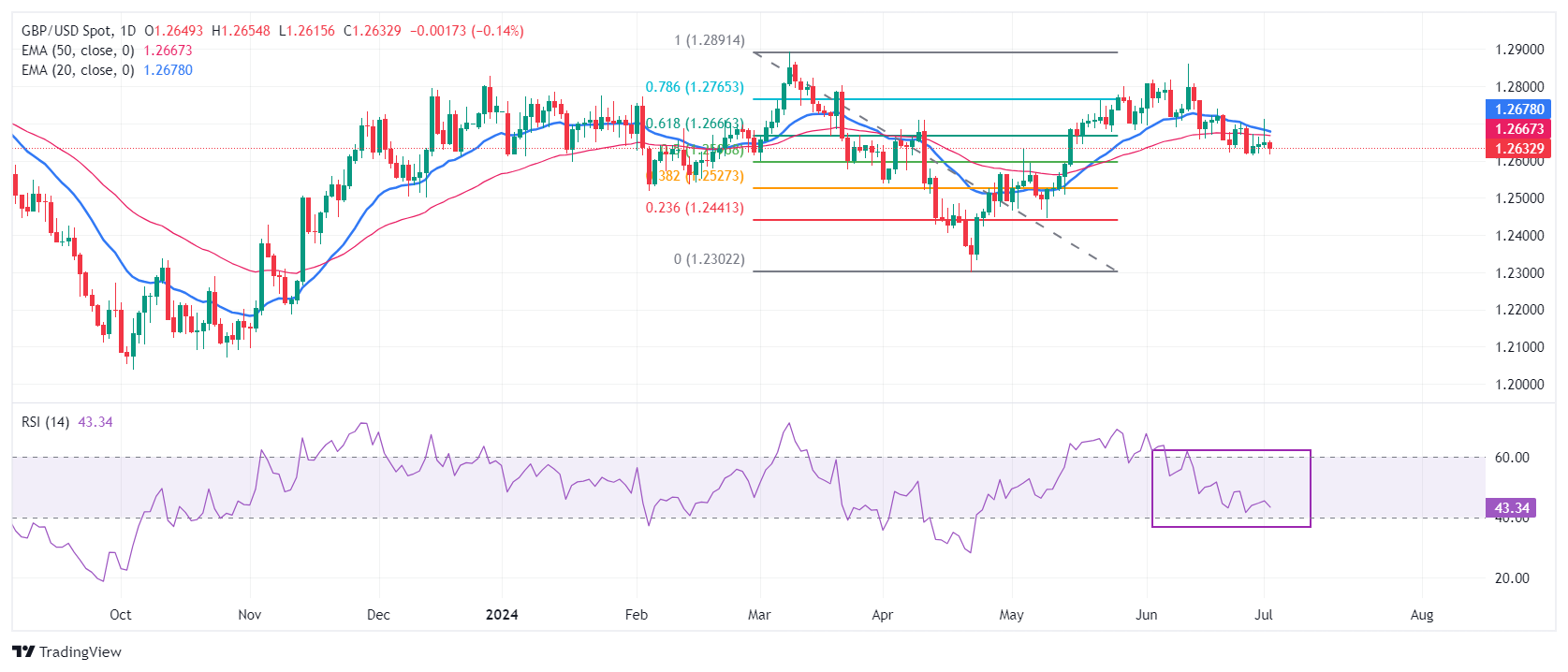- The Pound Sterling jumps against the US Dollar as Fed Powell sees quite a bit of progress in disinflation.
- UK’s annual shop price inflation decelerated to its lowest since October 2021.
- The BoE may start cutting interest rates in August.
The Pound Sterling (GBP) recovers sharply after retracing to 1.2620 against the US Dollar (USD) in Tuesday’s New York session. The GBP/USD pair rebounds as the US Dollar (USD) surrenders of its gains after Federal Reserve (Fed) Chair Jerome Powell said in his speech at the European Central Bank (ECB) Forum on Central Banking that disinflation appears to have resumed. Fed Powell added that the central bank has made quite a bit of progress in inflation but said that more good inflation data is needed before reducing interest rates. Powell's comments were much more in line with estimates and his speech delivered at the June policy meeting.
This week, investors will pay close attention to the United States (US) Nonfarm Payrolls (NFP) data for June, scheduled on Friday. The labor demand and the wage growth data will indicate whether the Fed should start reducing interest rates from the September meeting, as indicated by 30-day Federal Fund futures pricing data from the CME FedWatch tool.
Meanwhile, the US Bureau of Labor Statistics (BLS) has reported upbeat JOLTS Job Openings data for May. The number of fresh job vacancies came in at 8.14 million, higher than estimates of 7.90 million, and the prior release of 8.06 million.
Daily digest market movers: Pound Sterling bounces back against its major peers
- The Pound Sterling recovers against its major peers from Europe, Asia and the Asia-Pacific but is underperforming against North American currencies in Tuesday’s session. The British currency attracts bids even though easing United Kingdom (UK) price pressures have boosted expectations of early rate cuts by the Bank of England (BoE).
- The British Retail Consortium (BRC) showed on Monday that the annual shop price inflation grew 0.2% in June, at the slowest pace since October 2021, decelerating significantly from May’s reading of 0.6%. The agency also reported that food inflation slowed straight for 14 months, declining to 2.5% from 3.2%, and prices for non-food items fell by 1.0% year-on-year, Reuters reported.
- It is worth noting that annual headline inflation, as measured by the Consumer Price Index (CPI), has already returned to the bank’s target of 2%. High inflation in the service sector continues to be a major concern for BoE officials. Policymakers see service inflation as the preferred gauge for price pressures and want it to decline significantly to gain confidence for pivoting to policy normalization.
- Currently, investors expect the BoE to start reducing interest rates at its upcoming meeting in August.
- Meanwhile, the revised estimates for the manufacturing sector showed that factory activities expanded modestly in June. The S&P Global/CIPS Manufacturing PMI report showed on Monday that the factory activity fell to 50.9 from the preliminary reading and the estimates of 51.4. However, it remained above the 50.0 threshold that separates expansion from contraction.
Pound Sterling Price Today:
British Pound PRICE Today
The table below shows the percentage change of British Pound (GBP) against listed major currencies today. British Pound was the strongest against the Swiss Franc.
| GBP | EUR | USD | JPY | CAD | AUD | NZD | CHF | |
|---|---|---|---|---|---|---|---|---|
| GBP | 0.23% | 0.16% | 0.23% | -0.09% | 0.13% | 0.27% | 0.36% | |
| EUR | -0.23% | -0.10% | -0.03% | -0.36% | -0.10% | -0.00% | 0.11% | |
| USD | -0.16% | 0.10% | 0.03% | -0.26% | -0.01% | 0.12% | 0.22% | |
| JPY | -0.23% | 0.03% | -0.03% | -0.30% | -0.03% | 0.06% | 0.16% | |
| CAD | 0.09% | 0.36% | 0.26% | 0.30% | 0.26% | 0.38% | 0.47% | |
| AUD | -0.13% | 0.10% | 0.00% | 0.03% | -0.26% | 0.12% | 0.21% | |
| NZD | -0.27% | 0.00% | -0.12% | -0.06% | -0.38% | -0.12% | 0.09% | |
| CHF | -0.36% | -0.11% | -0.22% | -0.16% | -0.47% | -0.21% | -0.09% |
The heat map shows percentage changes of major currencies against each other. The base currency is picked from the left column, while the quote currency is picked from the top row. For example, if you pick the British Pound from the left column and move along the horizontal line to the US Dollar, the percentage change displayed in the box will represent GBP (base)/USD (quote).
Technical Analysis: Pound Sterling recovers to near 61.8% Fibo retracement support around 1.2660
The Pound Sterling recovers losses against the US Dollar after correcting to near the round-level resistance of 1.2600. The GBP/USD pair rebounds to near the 61.8% Fibonacci retracement support at 1.2667, plotted from the March 8 high of 1.2900 to the April 22 low at 1.2300.
The Cable falls below the 20-day and 50-day Exponential Moving Averages (EMAs) near 1.2675 and 1.2666, respectively, suggesting that the near-term outlook is bearish.
The 14-day Relative Strength Index (RSI) oscillates in the 40.00-60.00 range, indicating indecisiveness among market participants.
Fed FAQs
Monetary policy in the US is shaped by the Federal Reserve (Fed). The Fed has two mandates: to achieve price stability and foster full employment. Its primary tool to achieve these goals is by adjusting interest rates. When prices are rising too quickly and inflation is above the Fed’s 2% target, it raises interest rates, increasing borrowing costs throughout the economy. This results in a stronger US Dollar (USD) as it makes the US a more attractive place for international investors to park their money. When inflation falls below 2% or the Unemployment Rate is too high, the Fed may lower interest rates to encourage borrowing, which weighs on the Greenback.
The Federal Reserve (Fed) holds eight policy meetings a year, where the Federal Open Market Committee (FOMC) assesses economic conditions and makes monetary policy decisions. The FOMC is attended by twelve Fed officials – the seven members of the Board of Governors, the president of the Federal Reserve Bank of New York, and four of the remaining eleven regional Reserve Bank presidents, who serve one-year terms on a rotating basis.
In extreme situations, the Federal Reserve may resort to a policy named Quantitative Easing (QE). QE is the process by which the Fed substantially increases the flow of credit in a stuck financial system. It is a non-standard policy measure used during crises or when inflation is extremely low. It was the Fed’s weapon of choice during the Great Financial Crisis in 2008. It involves the Fed printing more Dollars and using them to buy high grade bonds from financial institutions. QE usually weakens the US Dollar.
Quantitative tightening (QT) is the reverse process of QE, whereby the Federal Reserve stops buying bonds from financial institutions and does not reinvest the principal from the bonds it holds maturing, to purchase new bonds. It is usually positive for the value of the US Dollar.
Information on these pages contains forward-looking statements that involve risks and uncertainties. Markets and instruments profiled on this page are for informational purposes only and should not in any way come across as a recommendation to buy or sell in these assets. You should do your own thorough research before making any investment decisions. FXStreet does not in any way guarantee that this information is free from mistakes, errors, or material misstatements. It also does not guarantee that this information is of a timely nature. Investing in Open Markets involves a great deal of risk, including the loss of all or a portion of your investment, as well as emotional distress. All risks, losses and costs associated with investing, including total loss of principal, are your responsibility. The views and opinions expressed in this article are those of the authors and do not necessarily reflect the official policy or position of FXStreet nor its advertisers. The author will not be held responsible for information that is found at the end of links posted on this page.
If not otherwise explicitly mentioned in the body of the article, at the time of writing, the author has no position in any stock mentioned in this article and no business relationship with any company mentioned. The author has not received compensation for writing this article, other than from FXStreet.
FXStreet and the author do not provide personalized recommendations. The author makes no representations as to the accuracy, completeness, or suitability of this information. FXStreet and the author will not be liable for any errors, omissions or any losses, injuries or damages arising from this information and its display or use. Errors and omissions excepted.
The author and FXStreet are not registered investment advisors and nothing in this article is intended to be investment advice.
Recommended content
Editors’ Picks

EUR/USD recovers to 1.0300 as traders await US NFP
EUR/USD has erased losses to trade modestly flat at around 1.0300 in European trading on Friday. However, concerns over US President-elect Trump's policies and hawkish Fed expectations keep the US Dollar afloat ahead of the US Nonfarm Payrolls data, capping the pair's rebound.

GBP/USD bounces back to 1.2300, US NFP eyed
GBP/USD is bouncing back to near 1.2300 after finding fresh demand in the European session on Friday. Despite the rebound, the pair remains vulnerable amid persistent US Dollat strength and the UK bond market turmoil. The focus now shifts to the US labor market data for fresh directives.

Gold price prolongs multi-day-old uptrend, refreshes multi-week top ahead of US NFP
Gold price (XAU/USD) gains some follow-through positive traction for the fourth consecutive day and touches a fresh four-month peak, around the $2,680 region during the first half of the European session on Friday.

Nonfarm Payrolls forecast: US December job gains set to decline sharply from November
US Nonfarm Payrolls are expected to rise by 160K in December after jumping by 227K in November. US jobs data is set to rock the US Dollar after hawkish Fed Minutes published on Wednesday.

How to trade NFP, one of the most volatile events Premium
NFP is the acronym for Nonfarm Payrolls, arguably the most important economic data release in the world. The indicator, which provides a comprehensive snapshot of the health of the US labor market, is typically published on the first Friday of each month.

Best Forex Brokers with Low Spreads
VERIFIED Low spreads are crucial for reducing trading costs. Explore top Forex brokers offering competitive spreads and high leverage. Compare options for EUR/USD, GBP/USD, USD/JPY, and Gold.
